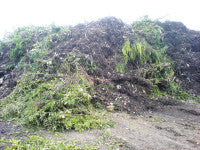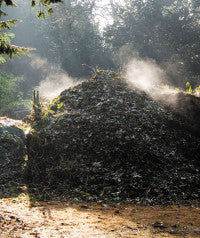Get Real! Muck and magic or simply magic
 Recycled Green Compost, or as it is better known in most other parts of the globe, "real compost", is already widely used and accepted as a beneficial organic amendment in New Zealand, Australia, the USA and the majority of our neighbouring European relatives.
Recycled Green Compost, or as it is better known in most other parts of the globe, "real compost", is already widely used and accepted as a beneficial organic amendment in New Zealand, Australia, the USA and the majority of our neighbouring European relatives.
The UK has been one of the more reticent countries to take up the compost baton and run with it. The majority of green compost produced as a result of us taking our garden waste to the local council tip site is used by councils as a land restoration product and soil improver for infertile soils.
Currently, our company utilises in the region of 50,000 tonnes of fully certified pas100/2005 Recycled Green Compost from Cheshire County Council and this equates to around 60% of the total produced by South Cheshire. The remainder is still used by the authority for its own maintenance and land improvement projects. We are currently the major supplier of compost amended products into the sports and amenity sector in the U.K. and we only use around 50,000 tonnes. The UK now produces in excess of 2 million tonnes of certified green compost per annum.
So, why has the U.K. sports industry not really got it yet?
There are still some misconceptions that abound in our industry. Some of these have been pretty well answered by a lengthy STRI study into the use of green compost on both fine turf and sports field applications. The research is to be found on the WRAP website (www.wrap.org.uk) and is very interesting.
In my own opinion I believe the research should be continued and modified to take account of the more realistic way we use compost on these types of applications, i.e. as a dressing material where sand is the main constituent; the study used only neat compost applications. This said, the research showed very well the value of green compost as a foliar feed and its possible disease suppressing abilities.
So, the main misconception -compost is an inconsistent material isn't it?
Pas100/2005 certified green compost is, without doubt in my mind, the most consistent of all available organic amendments. It takes us twelve to fourteen weeks to change garden waste into certified green compost. Within seven days the temperature within the windrow achieves a reading of 55-65OF. During the full period of gestation the temperatures will reach as high as 130 - 140OF and will eradicate weed and disease pathogens that are potentially harmful to fine turf areas.
Along with checking the temperature, producers also control the moisture contents, turn the rows regularly to increase the oxygen content and do regular tests to check on bacteria and heavy metals content. Indeed, during the composting procedure at least 18 sets of samples are taken and independently tested to ensure full conformity to the WRAP and Compost Society guidelines.
The tests include checks for the following; toxins, cadmium, chromium, copper, lead, mercury, nickel and zinc, and salmonella and escherichia pathogens. Unless it complies with all criteria tolerances, it does not get a certificate.
Topsoils are certainly not tested anywhere near as stringently and are many times more inconsistent. Even Reed Sedge Peat and Fenland Soils, which are very similar organically, whilst much more consistent than ordinary topsoils, are not tested as well and are also not consistent from one field section to the next. Probably the most consistent organic is sphagnum moss peat.
However, this product is sterile and, without amendments, is not able to offer any benefits to any growing medium other than to hold onto nutrients and moisture. Green compost inconsistent - what do you think now?
Contamination is an issue, isn't it?
Back to the very strict quality assurance schemes operated at all WRAP approved pas100/2005 producers. Green compost is tested for the mean number of weed seeds per litre with the upper limit being 0%.
Maximum permissible levels of glass, metal, stone etc. is 0.5%. Again, show me even a virgin topsoil which does not contain some stones, glass, pottery etc.
Green compost is tested through six bsi standard test procedures prior to being awarded the pas100/2005 certificate showing it has achieved the very high standards required.
So, having dismissed the main mythical concerns, let's get positive and discuss the tried and proven real benefits of real compost. Recycled green compost which is certified offers the following:
1) Low Bulk Density. Typically 0.8 to 1t/m3. Standard topsoils are usually 1.6 to 1.8t/m3. Real terms, a 500m2 green will require 40 to 50 tonnes less sand/compost rootzone than sand/topsoil rootzone. Real time cost saving.
Likewise, a compost amended topdressing is lighter and thus every tonne will spread further than the same tonne of sand/topsoil amended topdressing. Typically, a sand/topsoil amended dressing needs to be at least £4 per tonne cheaper than the equivalent sand/compost dressing to be more economical to apply!
2) Fungicide. Proven to be useful as a preventative treatment for many of the major fungal diseases which attack fine turf and sports turf alike. Whilst it is a preventative it is not, however, a curative treatment; still, I would rather take vitamin c to prevent a cold than have to take antibiotics to get rid of the chest infection that usually follows it, wouldn't you?
3) Increases moisture infiltration alongside the actual soil moisture holding capability in lighter soils and sandy rootzones.
4) Provides a variety of micro and macro nutrients, some in slow release form which reduces the reliance on chemical fertilisers.
5) Improves resistance to soil compaction and erosion.
6) Overall improves plant health from germination through to maturity.
Proven and scientifically researched benefits, not muck and magic after all.
Remember though, when buying compost there is only one to buy, the Compost Association certified one. If your supplier cannot give you a certificate, he probably doesn't have one!
Visit the WRAP website, www.wrap.org.uk and check out the STRI research and also the many case studies undertaken on golf, soccer and even racecourses over the last three years.
As you will gather, I am already a compost convert having researched it myself both here and in the US. I suspect if you all do your own research you, too, will switch to compost as your preferred organic amendment for your sports facility. Using compost should become part of your club's sustainability programme.
Andy Law, Managing Director, Whitemoss Eco Supplies
Web site www.whitemosseco.co.uk
